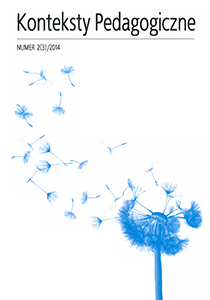Abstract
The sexuality of disabled men and women is taboo. In Poland, until now, there has never been a sexual rehabilitation program for the disabled after spinal cord injury. The aim of the empirical research carried out was to identify the main barriers associated with active sex life after spinal cord injury and to present the patients’ expectations of their sexual rehabilitation. An important aspect of the study was the question of the physiotherapist’s role insexual rehabilitation. The study included 12 women and 48 men with spinal cord injury. The authors used a questionnaire consisting of 22 questions, which was sent by email to the respondents. The research participants most often mentioned these concerns about having an intercourse: psychological barriers and the inability to control their physiological reflexes during sexual contacts. The demand for sexual rehabilitation of persons with physical disabilities is very large, and the most expected forms of assistance are: sexual instruction and support in overcoming the fear of involuntary physiological reflexes. However, not all forms of rehabilitation have been positively evaluated by the respondents, for example the services of a standin partner have not found acceptance among them.
References
Alexander C.J. et al., Sexual activities, desire, and satisfaction in males pre- and post-spinal cord injury, „Archives of Sexual Behavior” 1993, vol. 22, no. 3.
Bartoszek A., Seksualność osób niepełnosprawnych. Studium teologicznomoralne, Katowice 2009.
Block B., Osobowościowe uwarunkowania nasilenia problemów psychospołecznych u osób z uszkodzeniem rdzenia kręgowego, Lublin 1999.
Daszykowska J., Jakość życia w koncepcjach związanych ze zdrowiem, „Przegląd Medyczny Uniwersytetu Rzeszowskiego”, Rzeszów 2006.
Davies D., Sex and Relationship Facilitation Project for People with Disabilities, „Sexuality and Disability” 2000, vol. 18, no. 3.
Dembińska M., Seks specjalnej troski, www.kampaniespoleczne.pl [dostęp: 27.04.2012].Diagnoza potrzeb i modele pomocy dla osób z ograniczeniami sprawności, red. K. Smoczyńska, A.I. Brzezińska, R. Kaczan, Warszawa 2010.
Fiedorowicz A., Kalecy, ale nie w łóżku, http://www.focus.pl/cywilizacja/zobacz/publikacje/kalecyaleniewlozku [dostęp: 23.02.2012].
Franek A., Integracja dorosłych niepełnosprawnych, t. 1: Idea integracji a wychowanie: ku pedagogice integralnej, (seria Integracja, Nauczyciel, Wychowanie), Kraków 2004.
International Classification of Impairments Disabilities and Handicaps, World Health Organisation, Geneva 1980.
Izdebski Z., Postawy wobec seksualności osób niepełnosprawnych, [w:] M. Kościelska, B. Aouil, Człowiek niepełnosprawny. Rodzina i praca, Bydgoszcz 2004.
Kirenko J., Psychospołeczne determinanty funkcjonowania seksualnego osób z uszkodze-niem rdzenia kręgowego, Lublin 1998.
Kirenko J., Z badań nad funkcjonowaniem seksualnym osób z uszkodzeniem rdzenia kręgowego, [w:] M. Chodkowska, Pedagogika specjalna wobec potrzeb teraźniejszości i wyzwań przyszłości, Lublin 1998.
Kopaniszyn I., Seks po urazach rdzenia kręgowego, [w:] Wybrane uwarunkowania rehabi-litacji osób niepełnosprawnych, red. J. Rottermund, A. Klinik, Kraków 2005.
Kościelska M., Aouil B., Człowiek niepełnosprawny. Rodzina i praca, Bydgoszcz 2004.
Kościelska M., Niechciana seksualność. O ludzkich potrzebach osób niepełnosprawnych intelektualnie, Warszawa 2004.
LewStarowicz Z., Życie intymne osób niepełnosprawnych, Warszawa 1999.
ŁuczakPiechowiak A. et al., Fizykoterapia w spastyczności, „Balneologia Polska” 2008, nr 3.
Mead S., Knott M.,Topical cryotherapy –use for relief of pain and spasticity, „Calif. Med.” 1966, no. 105.
Migas A., Seksualność i życie rodzinne osób z ograniczoną sprawnością fizyczną, „Niepełnosprawność i Rehabilitacja” 2007, t. 7, nr 4.
Nicotra A. et al., Emotional and autonomic consequences of spinal cord injury explored using functional brain imaging, „Brain” 2006, no. 129.
Ogonowski A. et al., Neurogenne skostnienia okołostawowe w przebiegu rehabilitacji cho-rych z uszkodzeniem rdzenia, „Postępy Rehabilitacji” 1994, t. 8, supl. I.
Ossowski R., Jakość życia – efektywne pełnienie ról społecznych i zawodowych jako wskaź-nik udanej rehabilitacji, [w:] M. Kościelska, B. Aouil, Człowiek niepełnosprawny. Rodzina i praca, Bydgoszcz 2004.
Ostrowska A., Imieliński K., Seks ludzi niepełnosprawnych fizycznie, [w:] K. Imieliński, Miłość i seks, Warszawa 1980.
Ostrowska A., Sikorska J., Sufin Z., Sytuacja ludzi niepełnosprawnych w Polsce (raport z badań), Warszawa 1994.
Radomski D., Czynniki utrudniające realizację życia erotycznego osób niepełnosprawnych fizycznie, „Seksuologia Polska” 2005, t. 3, nr 1.
Schirmer M. et al., Neurochirurgia, przeł. P. Słoniewski, Wrocław 1998.
Schorzenia i urazy kręgosłupa, red. J. Kiwerski, Warszawa 2001.
Siosteen A. et al., Sexual ability, activity, attitudes and satisfaction as a part of adjustment in spinal cord injured subjects, „Paraplegia” 1990, vol. 28.
Soden R., Walsh J., Causes of death after spinal cord injury, „Spinal Cord” 2000, vol. 38.
Świat pełen znaczeń – kultura i niepełnosprawność, red. J. Baran, S. Olszewski, Kraków 2006.
Tederko P., Radomski D., Zdrowie seksualne osób po urazie kręgosłupa powikłanym za-burzeniami neurologicznymi, „Seksuologia Polska” 2009, t. 7, nr 2.
Witkowski T., Rozumieć problemy osób niepełnosprawnych, Warszawa 1993.
In accordance with the recommendation of the Ministry of Science and Higher Education, which aims to counteract the practice of “ghostwriting” and “guest authorship,” all authors submitting their text for publication should attach an author’s statement which declares the contribution of each of the authors to the article. The printed and signed statement should be delivered by mail or other means to editor-in-chief Joanna Skibska or sent in the form of a scan to the following e-mail address: redakcja@kontekstypedagogczne.pl. The authors will not receive remuneration for publishing their papers. The editors reserve the right to make minor editorial changes to the articles which will not affect the substance of the article. We encourage all authors to prepare their articles in accordance with the guidelines for manuscript preparation. Download pdf file.
Authors transfer all copyrights and grant the journal the right of first publication with the work simultaneously licensed under a Creative Commons Attribution License that allows others to share the work with acknowledgement of the work's authorship and initial publication in this journal. All authors agree to the publishing of their email addresses, affiliations and short bio statements with their articles during the submission process.

